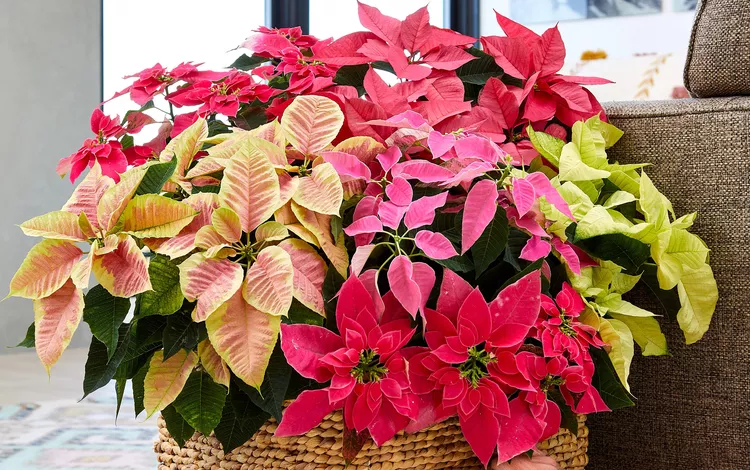It’s a sure sign the holiday season is here when poinsettias fill florist shelves, grocery store endcaps, and greenhouses at big box stores. These lush tropical plants look fabulous at the time of purchase but often take on a sickly appearance a few days later. Improper watering is usually the culprit.
Poinsettias are sensitive to too much or too little water and quickly show signs of stress in the form of yellow leaves and bare lower branches. These 8 smart watering tips will keep your poinsettias looking good until you ring in the new year.
1. Start with a healthy plant.
When shopping for a poinsettia, resist the urge to rescue a bedraggled plant. Poinsettias that have had a rough journey to the marketplace might have broken stems, limp or curled leaves, and limited foliage at the base of the plant. In general, these tender tropicals don’t recover quickly and will likely look less-than-festive for the duration of the holiday season.
Instead, search out a poinsettia with lush, brightly colored leaves and flowers—the button-like structures in the center of the leaf clusters—that are barely open and shedding no pollen. A healthy poinsettia easily keeps its good looks for six weeks or more.
2. Check the soil moisture daily.
Yes, daily. When soil is dry to the touch, it’s time to water. Poinsettias thrive when their soil is allowed to just barely dry out between waterings. Your goal is to water the plant the day the soil surface is dry to the touch.
Poinsettias are usually grown in a soilless mix that dries out rapidly because that type of soil most closely mimics their native soil. Poinsettias are tropical plants heralding from regions with light, sandy soil and frequent rain showers. Replicate these conditions in your home, and the poinsettia will be happy.
3. Remove the cover before watering.
Poinsettias despise soggy soil. When poinsettias are watered in their decorative covers, the excess water pools in the bottom of the cover, creating waterlogged soil. Before watering your plant, slip it out of the decorative plastic or paper cover. Replace the cover after all excess moisture has drained out of the pot.
4. Let your poinsettia soak.
An easy way to ensure poinsettias receive ample moisture at watering time is to set the plant—removing the decorative pot cover first—in a baking pan or shallow tray. Then, water the plant with room temperature water until the excess water runs out of the bottom of the pot. Leave the pot in the tray for 15-30 minutes. It will absorb any needed water that collects in the bottom of the tray.
5. Don’t leave water in the cover.
After letting your poinsettia soak, it's best to set your plant in a sink where any excess water can drip out before returning the pot to the decorative cover. Or if you want to just put it back in the cover, check back a little while later and dump out any unneeded water to prevent the plant’s soil from becoming waterlogged. The same applies if you use a saucer under your plant's pot instead of a cover.
6. Avoid nearby heat sources.
Vents, radiators—anything that is moving warm air—will cause the soil of nearby poinsettias to dry out more quickly. If possible, place your poinsettia near a sunny window, away from heat sources. Poinsettias thrive when the air temperature is 60°F to 70°F, and you won't have to water it quite as much.
7. Watch for yellow leaves.
Overwatering causes leaves on the bottom of the plant to turn yellow and drop off. In time, the lower half of the plant becomes a bunch of leafless stems. At the first sight of a yellow leaf, check the soil moisture. Do not water the plant until the soil surface is dry to the touch. Also, check the decorative pot cover to ensure excess water has not collected in the bottom, causing soggy soil.
8. Don't let your poinsettia wilt.
Poinsettias are quick to let you know when they desperately need water. Their leaves will look curled and droopy. Unfortunately, when poinsettias reach this point, their growth is often so compromised that it is difficult to return them to full health. While it's best to avoid letting your plant wilt even a little bit, if this does happen, water your stressed poinsettia as soon as you notice the problem, following the watering practices described above.




















